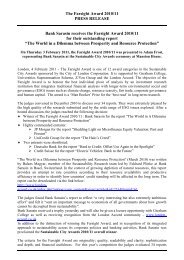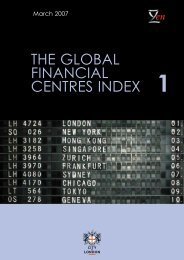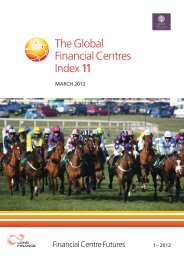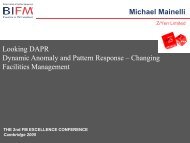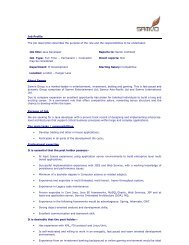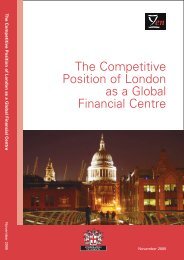The global financial centres index (GFCI) 3 - Z/Yen
The global financial centres index (GFCI) 3 - Z/Yen
The global financial centres index (GFCI) 3 - Z/Yen
You also want an ePaper? Increase the reach of your titles
YUMPU automatically turns print PDFs into web optimized ePapers that Google loves.
<strong>The</strong> Global Financial Centres Index<br />
What change in the ratings is considered significant At this<br />
stage in the development of the <strong>GFCI</strong>, a movement of less than<br />
ten points (1% on a scale of 1,000) is considered insignificant 4 .<br />
A movement of between 10 and 30 points signifies that the<br />
competitiveness of a <strong>financial</strong> centre needs to be watched.<br />
A movement of more than 30 points shows that a major change<br />
in the competitiveness of a <strong>financial</strong> centre may be under way.<br />
<strong>The</strong> top eight <strong>centres</strong> remain unchanged in rank since the<br />
previous <strong>index</strong>, with Sydney dropping below Tokyo from 9th to<br />
10th. Eight <strong>centres</strong> new to <strong>GFCI</strong> made the top 50 this year.<br />
Major movers include Jersey (+35), Guernsey (+31), Shanghai<br />
(+27), Bahrain (+59), Johannesburg (+48), and Qatar (+51). As in<br />
the previous two editions of the <strong>GFCI</strong>, this can be a result of a large<br />
variance in centre assessments (some respondents rate them<br />
highly and some respondents rate them poorly), or a high<br />
sensitivity to instrumental factors (their ratings react strongly<br />
to changes in instrumental factors), or both. Osaka showed<br />
the greatest fall in the ratings (-33), followed by Sydney and<br />
Melbourne (-15 each).<br />
Dubai and Qatar, both identified in <strong>GFCI</strong> 2 as emerging, volatile<br />
<strong>centres</strong>, have continued to gain significance in <strong>GFCI</strong> 3,<br />
highlighting their role as important regional <strong>financial</strong> hubs in the<br />
Middle East and beyond. <strong>The</strong> consistently high price of oil and<br />
massive investments by national governments in the creation of<br />
<strong>financial</strong> hubs have helped to raise these two <strong>centres</strong> in the Index.<br />
Whether they can continue to climb depends on many factors,<br />
not least of which is broad improvement in all five competitive<br />
aspects, in particular <strong>financial</strong> infrastructure, where both received<br />
relatively low scores.<br />
Some <strong>centres</strong> are no longer in the top 50 of <strong>GFCI</strong> 3, for a variety of<br />
reasons. Some are now substantially lower in rank without a<br />
corresponding drop in rating (Mumbai, Rome, Seoul, Wellington,<br />
Sao Paulo, Prague and Warsaw) as a result of new <strong>centres</strong> being<br />
added and scoring more highly in the Index. Osaka, in contrast,<br />
dropped 18 ranks, but also lost 33 points in the <strong>GFCI</strong> ratings, which<br />
indicates that more than just a ‘displacement’ effect is taking<br />
place since <strong>GFCI</strong> 2.<br />
Other <strong>centres</strong> deserve note as well. Wellington, which had<br />
fallen 61 points in <strong>GFCI</strong> 2 and was highlighted as particularly<br />
sensitive, dropped completely out of the top 50 in <strong>GFCI</strong> 3.<br />
Shanghai again demonstrated its volatility, rising 27 points after<br />
dropping 49 in <strong>GFCI</strong> 2.<br />
4 In <strong>GFCI</strong> 2 we estimated<br />
significance at 25 points,<br />
and highlighted that the<br />
threshold would fall with<br />
the expansion of the<br />
data set and duration of<br />
the <strong>GFCI</strong>.<br />
13




